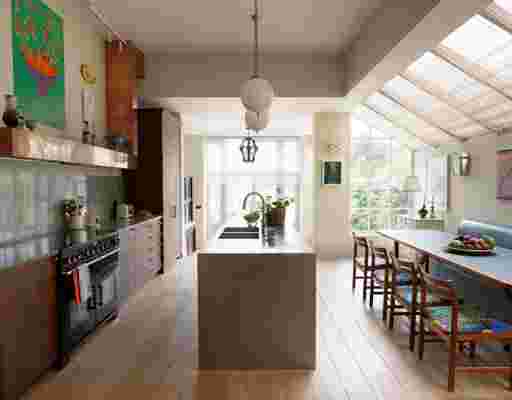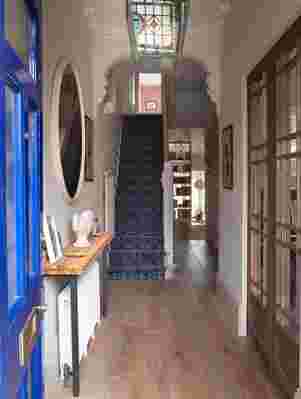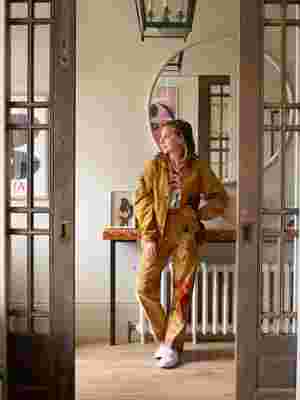Step Inside a Charming Queen's Park, London, Home Transformed by Beata Heuman
After working from home, it’s going to be hard to go into the office,” says a 30-something London media man who counts himself lucky to have spent a surprisingly blissful lockdown with his wife and twin toddler daughters. “Three meals a day in the kitchen, using the spare room in the attic as an office—it’s been a pleasure to spend so much time here,” he says of the family’s circa-1903 redbrick charmer in Queen’s Park, a bohemian enclave in northwest London. “I’m not sick of anything. I thought the colors were going to be a bit much, but they’re wonderful. There’s a real harmony about the place, but it’s not too serious; you don’t have to be on your best behavior. She has such a skill for stylishness but also how to make a home.”

A stainless-steel island centers the new kitchen. Rangemaster range ; remains lighting (foreground) and Vaughan pendants.
She would be Beata Heuman, the Swedish-born, London-based It girl of the AD100: young, droll, creative, and envelope- pushing. The couple crossed paths with Heuman and her husband at dinners and the convivial like, but they weren’t familiar with her work until late 2016, just before they bought a four-bedroom terraced house in a decidedly woeful state—one room literally had a massive mushroom growing on a wall—and decided they needed assistance. “We saw her Instagram and said, ‘Holy hell, she’s brilliant,’ ” the husband recalls. As for Heuman’s freewheeling sense of adventure, that became readily apparent soon after the epic renovation, with architect Joseph Edwards, began. The thorough refresh included preserving and restoring many original elements—what the husband calls “the layers of life”—such as carved-stone mantels that more timid souls might have found irredeemably ugly rather than delightfully odd.

A custom-made runner by Heuman rises up the staircase. Vaughan lantern; Farrow & Ball paint on walls and woodwork.

Designer Beata Heuman in the entrance hall, framed by vintage brass sliding doors.
“Just when you get your head around an idea Beata proposed, another one turns up,” the wife, who works in film and television and is used to spontaneous creativity, explains. “There was a lot of that. And we’d say, ‘Wow, okay, let’s try it.’ Most of the time, she was completely right.” That includes suggesting a surprisingly operatic sofa for the so-called snug, a cozy television room that’s clad in a big, bold tiger-print fabric that the clients found on their own, to Heuman’s mixmaster delight. (She had proposed striping the walls, but, the wife says, “Our instinct was to do something crazy.”)
In the main bedroom, Soane Britain reading lights peer around a custom headboard dressed in a Guy Goodfellow collection stripe. Pendant light by Gong; wall covering by Phillip Jeffries ; Volga linen bedsheets; bed-skirt fabric by Soane Britain .
Sheltered beneath a towering canopy, the seat was inspired by the delirious 18th-century chinoiserie daybeds at Stanway House, the Earl of Wemyss’s Jacobean ancestral pile in Gloucestershire. Though the husband initially had misgivings (“How will I tell my friends I have a canopied sofa?”), he has become its biggest fan, lolling there with his daughters, reading books, or watching the television that’s concealed behind a zodiac-painted panel above the fireplace.
Heuman designed a plaster pendant and swan brackets for the main bath. Window blind of a Christopher Farr cloth fabric with Samuel & Sons braid.
In Heuman’s world, there’s no reason to have a standard-issue oven hood, to cite yet another example of her cheerfully contrarian aesthetic. In the sunny new kitchen that extends into the garden at the rear of the house, smoke-extract pipes are concealed within a copper sheath-cum-shelf that snakes across a wall like a smartened-up piece of industrial flotsam. “In farms in Sweden, you see pipes clad in metal and which you can use for storage, too,” explains the designer, noting that the copper sheets, pieced together with matching nailheads, have “a lovely reflectiveness and will darken over time.”
Details like that are really brilliant,” the husband enthusiastically observes. A colorful jungle-like mosaic, made by a family friend, surrounds the children’s bath. Wafer-thin reeded paneling wainscots a tiny powder room without encroaching on the space. Ribbonlike brass handles handmade by Florentine craftsmen ornament cabinets. Heavy brass doors, which once graced the BBC’s former headquarters, now slide open to the living room. “I love the history of them, but the builders weren’t very happy,” the husband continues. A couple of years ago, he and his wife missed the chance to purchase an 1870s Aesthetic Movement cabinet at the Masterpiece London art-and-antiques fair, so Heuman channeled a magnified adaptation for the main bedroom. The wall-spanning armoire that resulted is hand-painted, Cocteau style, with the sun and moon and spattered with stars. “I wasn’t expecting it to be so huge, but it’s so theatrical and wonderful and magical,” the wife says, adding that she can imagine her girls seeing it as an entrance to Narnia. “That’s what Beata’s brilliant about: She captures something in the imagination and makes it more romantic.”
Borderline fabric curtains in the main bedroom, along with a custom-made wardrobe.
Heuman designed a canopied sofa for the family room, a.k.a. the snug; silk wall covering by Dedar .
The otherworldliness that Heuman conjured has kept the family from going stir-crazy during monthslong sheltering at home. “So much of what some of us do can be done at home and sometimes a lot more effectively,” the husband says, adding that although many people have been uneasily stripped of their business personae during the pandemic, for him, “it’s been great to pop down, have fun with the kids, and then head back upstairs. Terrible things have happened in the world, but there have been wonderful moments, too.”